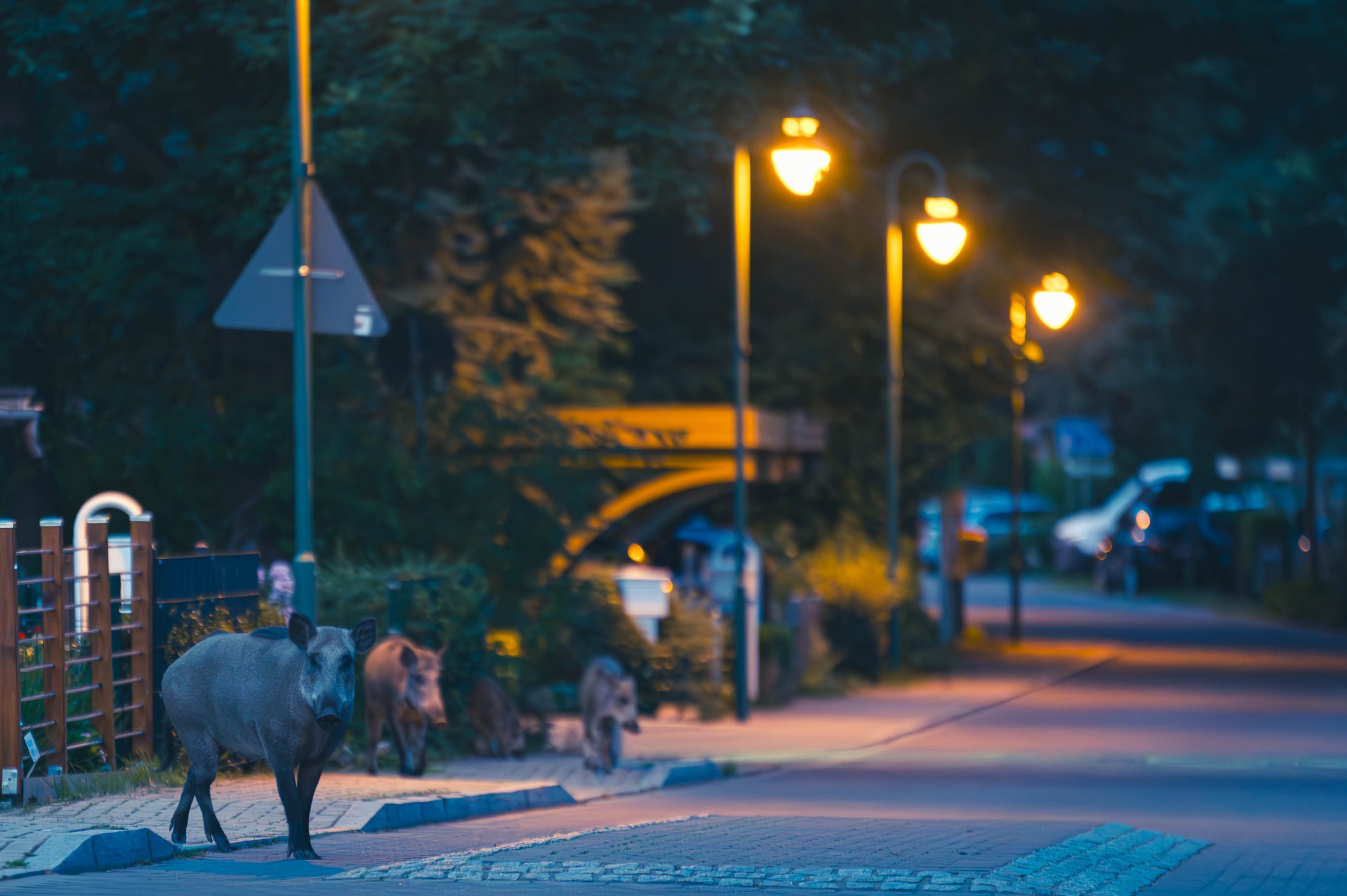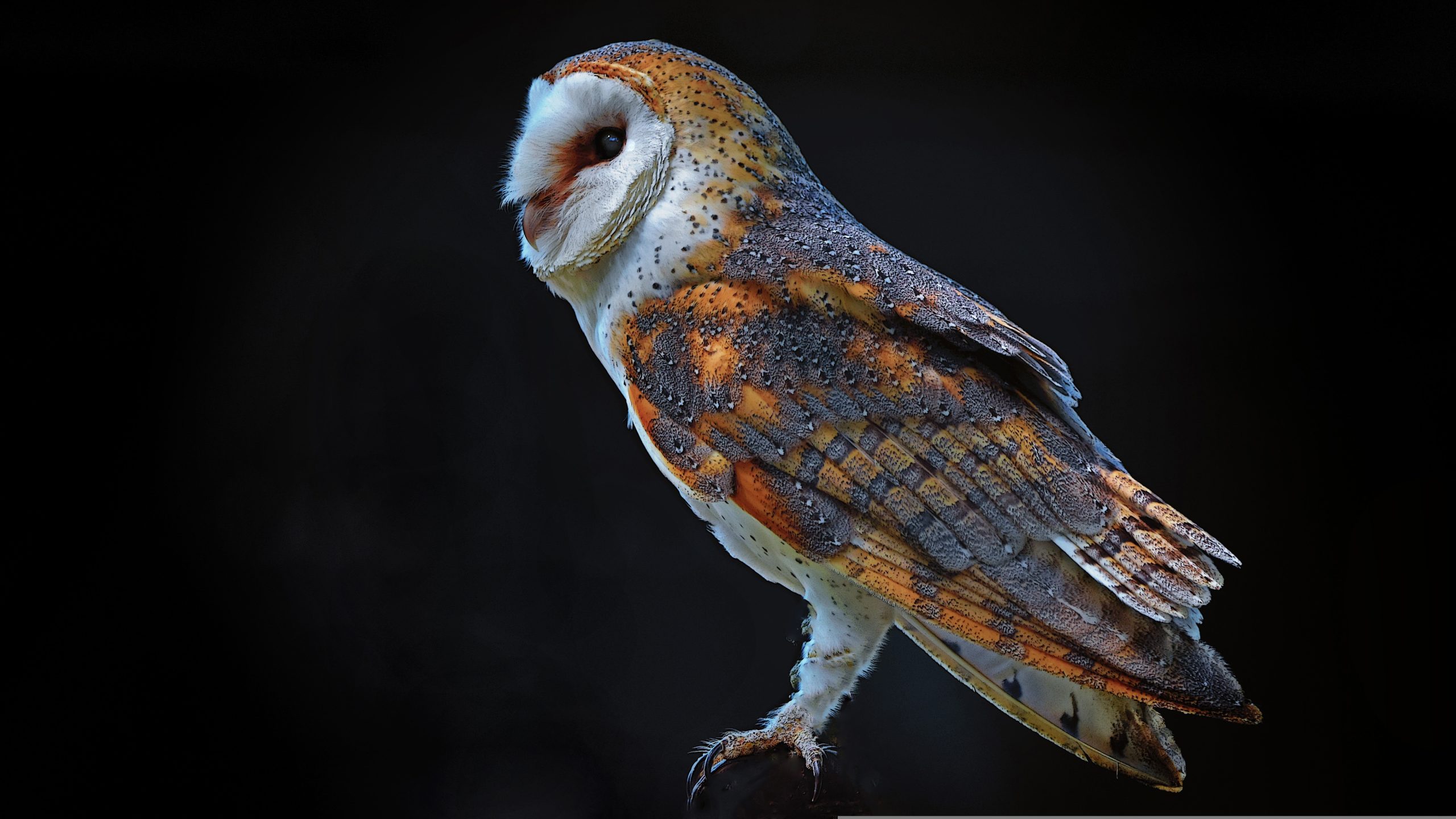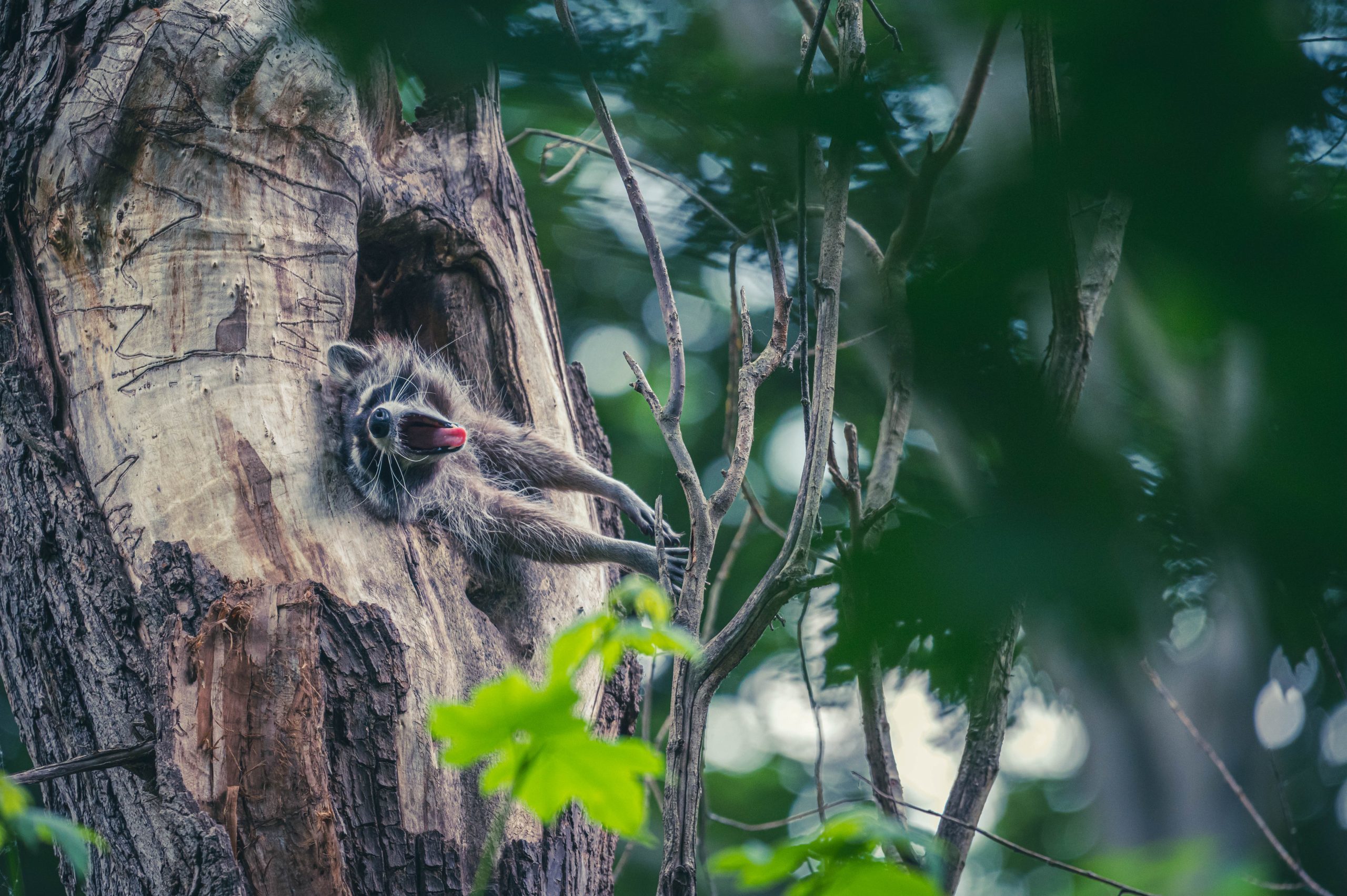The following is an extended excerpt from Living Night by Sophia Kimmig.
Simply put, it’s exciting. And the nocturnal wildlife in front of your doorstep is exciting. It is unusual, intriguing, astonishing, and extraordinarily beautiful.
For years, I went about my life without noticing it, the dark world. I never gave it a thought. And yet, it’s not all that far away, it’s not hidden away in some far-flung place. It’s right under our noses. Imagine a city or a village—perhaps where you live. At night, it will look completely different from how it does during the day. The scene might be similar—if a little more dimly lit—but the main characters are altogether different. Under cover of darkness, they assume control of the city unnoticed by us. Let’s visit my hometown briefly and take a closer look.
It’s 1:00 AM in Berlin’s embassy district. It’s a mild night, but the last breath of winter is still hanging in the cool air. At the Westend stop on the M45 bus line, a small, lonely bus shelter stands in the light of a streetlight. The lamp casts its glow on the empty benches, illuminating the cobblestones and placards, which loom out of the darkness in shades of gray and are lost in the dark foliage of the hedges and trees of the adjacent park.
If you look closely, you can just about make out a dark spot amid the bushes, a deeper black than everything around it. A rustling is coming from this spot, interrupting the nighttime hush. Quiet at first, it grows louder, with a twitching of twigs, a rustling of leaves, and a cracking of branches.
A squat figure steps out of the darkness, pausing briefly to listen. A long snout ending in a large, soft nose moves into the lamplight. The sow’s head almost seems too small when compared to her large, bristly body. Her button eyes are alert, her big ears pricked up attentively as she walks out onto the curb. Behind her, tiny bodies bearing pale stripes peel themselves away from the undergrowth. First one, then a second, and a third. Little by little, the space around the small bus shelter fills with a drove of wild boars. Leading her seven piglets, this seasoned sow is making for the garbage can on the side of the shelter, and she heads toward it now, hoping to forage for something to eat while little noses search the ground for acorns and other nutritious treats. The family enjoys their meal amid a chorus of champing and grunting. It’s breakfast time for the boars; for them, the day has only just begun.
Six and a half hours later, around 7:30 AM, the Westend bus shelter is a hive of activity once again. Inside the shelter, a man sits on the bench, holding a backpack on his lap; a woman sits next to him, absentmindedly rocking a stroller. Next to the streetlamp, its light switched off, is a man in a suit; he throws his coffee cup into the recycling bin. People swarm along the curb as their bus arrives. They are going to work, taking their children to day care, running errands, going about their morning routines; they haven’t the faintest inkling of the nighttime creatures that visited their bus stop just hours before.

The goings-on at this bus shelter are just a tiny fraction of the nightlife that cities see playing out far from their bars and clubs. It is just a small portion of the nightlife in our towns and villages and just a sliver of the nightlife to which the natural world plays host. In the daytime, human beings wait for buses, mow lawns, or play soccer in the same spaces where the inhabitants of the nighttime world will soon be venturing out on soft-padding paws and silent wings. Bats hunt moths, foxes steal shoes, racoons search for food in garden ponds, and our various other wild neighbors begin their day’s work. Their night’s work, we should say, because the majority of their lives takes place at night. Whether they live in the countryside or in the city, most mammals are nocturnal. But they’re not the only ones; other animals have also opted for the darker side.
The other world
You know how it goes: Night follows day. So far, so normal. But have you ever really thought about what that means? Human beings sleep through a significant portion of the twenty-four-hour cycle. It’s not just a couple of hours we’re missing out on. It’s an entire world, a kind of mirror universe where everything is somehow the same and yet completely different. It’s as if life is split in two—two parallel worlds with their own creatures and rules, and their own realities.

It might not seem all that important that we live the overwhelming majority of our lives in just one of these two worlds, but it has far-reaching implications. It impacts us directly. Our skills and habits, our physiology, and much of what makes us human are all tightly bound up with our lifestyles as day-dwellers. It starts with how we orient ourselves, because our eyes—our keenest sense—are adapted to seeing in daylight. They break up complex scenes into wonderful, colorful, and clear images and help us to find our way in the world. However, as soon as night falls, we are reliant on sources of light, be they natural—such as fire, or the light of the full moon on a clear night—or the millions of artificial lights that we use to illuminate the night. We’re not entirely blind in natural darkness—and our eyes can definitely adapt to nighttime low-light conditions—but our night vision is severely limited.
Our sleep-wake cycle and hormone metabolism are also designed for us to be active predominantly during the day and to rest at night. In contrast to numerous other creatures who distribute their periods of sleep across the day, we are natural night sleepers and require darkness to enable us to release melatonin and enjoy restorative sleep. At the same time, light makes us feel alert and cheerful; it lifts our mood and improves our cognitive performance. This is particularly true of blue light, which occurs naturally in the spectrum of colors in visible light. Our affinity for blue is due to the molecule melanopsin; the photopigment in our retinas responds especially strongly to this color of light. While this can cheer us up during the day, however, it can keep us awake at night; the blue light from computer and phone screens can upset our hormones, which have developed over thousands of years, and disrupt our circadian clock. Living and working contrary to our natural rhythm can even make us ill. People who regularly work nights are at greater risk of cancer, cardiac issues, depression, and other illnesses. Hence, turning night into day isn’t the healthiest idea, but making an exception now and then won’t do us any harm, especially if it gives us wonderful insights into a world otherwise hidden from us.

Our diurnal lifestyle not only impacts our bodies; it also affects the way we perceive the world. Take, for instance, our understanding of the natural world around us. Let’s do a little experiment to illustrate: Try to think of the names of three butterflies. Which ones come to mind?
Monarchs, swallowtails, and painted ladies, perhaps? Then you’ve got the cabbage white, tortoiseshell, fritillary, mourning cloak, and orange tip. Which of these occurred to you? Even if their names didn’t come to mind, you’re certain to know a few of them. Now, let’s repeat the exercise, but this time with moths.
How was it? If none came to mind, don’t fret: You’re in the majority. Not too long ago, I would have struggled to name three. When I started working on a project examining natural darkness and its inhabitants, I had no idea just how little I knew. I primarily encountered raccoons, martens, and hedgehogs on my nighttime outings when I was working with foxes as part of my doctoral thesis. There were many other nighttime residents that I simply didn’t notice.
Spurred on by my ignorance of moths, I started researching, looking for different moths and their names, only to find that some species didn’t even have their own common names in my native German. On a page about moths in a children’s book, I discovered—alongside the names of the luna moth and the giant peacock moth—some rather less child-friendly names, like Eumorpha labruscae and Citheronia regalis. These are examples of the Latin species names given to all known living things, composed of the genus and species (for instance, Canis lupus for the wolf or Homo sapiens for modern human beings). No one had made an effort to give these wonderful creatures names in the language I use every day.
When we do give moths common names, they can be poetic (like clouded silver, pale beauty, and early gray) or romantic (like the true lover’s knot). They are spooky (the blood-vein and the feathered gothic), cute (the little thorn and the snout), misleading (the common swift and the garden tiger), and—occasionally—whimsical (like the figure of eighty and the common footman).
But out there in the darkness, there are thousands of beautiful, colorful, wildly patterned, transparent, or unusually shaped moths with amazing abilities (including the most subtle sense of smell known in the animal kingdom) that almost no one talks about.
It’s not just moths that are affected by our daytime bias. Many scientific findings on the world of plants and animals and beyond have been gleaned during the day, as nighttime investigations are underrepresented in science. But what difference does it actually make? Take a look at the proportion of nocturnal animals among the animal species on the Red List of Threatened Species, issued by the International Union for Conservation of Natures (IUCN), and something stands out. Nocturnal animals appear to be less hit by decline than other species.
However, it would probably be wrong to conclude that nocturnal animals are under less of a threat. Alongside many species on the Red List—as well as various categories of threat ranging from “least concern” to “extinct”—the letters “DD” appear: “data deficient”. This signifies that there is not a sufficient basis of data to classify the species and that we simply know too little about them to be able to assess the threats they face.
Over 80 percent of the 583 species labeled “DD” are nocturnal. By contrast, only 11 percent are diurnal. So when it comes to nocturnal species, we’re very much in the dark—if you can excuse the pun. We may be underestimating the risks they face, responding inadequately and too late.
To some extent, we know next to nothing about which areas of our scientific research are affected by our focus on the daytime. Just look at research on medication. For decades, medicines were—and all too frequently still are—predominantly tested on young male subjects. It was only later that we realized what this meant: It was still unclear whether the substances tested were effective for women, older people, or children. Subsequent studies aiming to ascertain this often came to alarming conclusions. Just as some illnesses can present entirely differently in women and men, medicines also do not work in the same manner for all people; in certain groups, their effects are almost imperceptible. This is a big problem, but we were ignorant of its existence for some time. So, who knows what effect our blind spot for darkness might have?
There is still a lot for us to learn about the night, and if we want to protect nature, we may well have to think in terms of time as well as space. For example, some scientists and conservationists suggest making conservation areas accessible to people at only certain times of day. Scientists believe this could better protect many species in a world where human settlements continue to encroach with ever greater density.
So, we should investigate the nighttime more thoroughly. First, from a scientific perspective: Scientists from various disciplines could devote themselves to studying the night, investigating topics such as the influence of artificial light on our ecosystems, the optimal start time for the school day, and the question of daylight saving time. It could even go a step further and incorporate the fields of philosophy, art, or anthropology. After all, our daytime bias has shaped the history of civilization itself. The physicist, writer, and philosopher Georg Christoph Lichtenberg addressed this topic all the way back in the eighteenth century: “Our entire history is merely the history of the waking life of man; nobody has yet considered the history of his sleeping life”.
Second, from our personal perspectives as human beings and creatures of the day: There are a whole number of reasons why we ought to pay greater attention to darkness and everything it conceals. But I always come back to what first pushed me to study biology, and also motivated me to explore my city’s nocturnal wildlife, the thing that urges me, day in and day out, to stick my nose in something and have a look around: Simply put, it’s exciting. And the nocturnal wildlife in front of your doorstep is exciting. It is unusual, intriguing, astonishing, and extraordinarily beautiful.
So, let’s dive into this secret sphere together. Join me on an expedition into the “Other World” in Living Night: On the Secret Wonders of Wildlife After Dark. May the book serve you as a source of discovery and joy as well as an inspiration to put aside the perspective of a day dweller and surrender all your senses to the night.
Sophia Kimmig
Leipzig
Credit line: Extended excerpt from Living Night: On the Secret Wonders of Wildlife After Dark © Sophia Kimmig, 2025. Reprinted by permission of the publisher, The Experiment. Available everywhere books are sold. theexperimentpublishing.com


